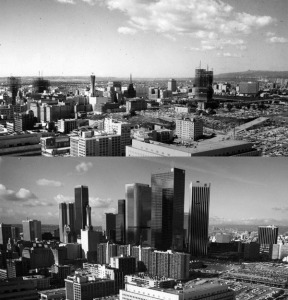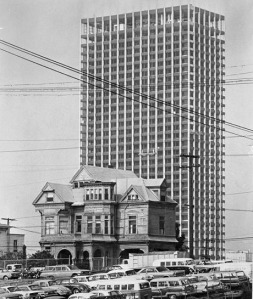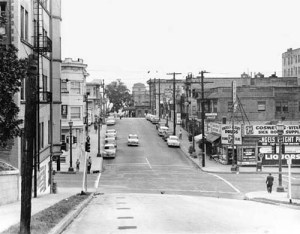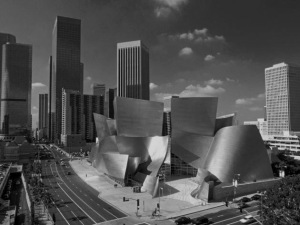SCENARIO2 Los Angeles: What We’ve Lost
Unlike most dense, urban cities, Los Angeles’ elevated skyline developed late, around the late 1950s and early 1960s. A height limit was set in the early 1900s. The primary reason was because of the fear of earthquakes. The skyscraper was still new in the early 1900s and especially after the San Francisco earthquake of 1906, it took some time for Angelinos to be comfortable with the idea of massive structures. Los Angeles also had land to develop so their first instinct was to expand horizontally, not vertically, creating the condition of “dense sprawl.”
Eventually, aesthetic and economic issues outweighed structural concerns. In 1956, the height limitations were loosened and massive structures were built, clearing residences and slums out of the area.
Bunker Hill, located within downtown LA, became a specific target during this time with two acts: the Housing Acts of 1949 & 1954 and the Bunker Hill Redevelopment Project of 1955. The Housing Acts of 1949 & 1954 aimed for urban redevelopment of slums into decent homes for low-income households. In reality, the acts wrongfully targeted Bunker Hill, a neighborhood of lavish Victorian homes, multi-unit housing, and small businesses adjacent to a bustling urban center. They considered Bunker Hill a blight to the city because the neighborhood was evolving; it no longer served only the elite whites but was becoming a more and more diverse neighborhood.
Bunker Hill was coherent. There was a sense of scale, so you had a thriving street life. 90% of the residents at the time didn’t even have a car. There were continuous facades. There was a neighborhood fabric that the post modern buildings that supplanted them couldn’t recreate. In the end, the Bunker Hill Redevelopment Project demolished 7,310 housing units.
What we’ve lost is our downtown and its fabric. The community that had developed in Bunker Hill and downtown before the 1950s number around 21,400. The combination of the acts noted above, as well as the Federal Aid Highway Act of 1956 that established the 10 and 110 freeways which further segregated the area, forced these residents out of the neighborhood, contributing to the horizontal dense sprawl.
The reduction of the population living in downtown LA destroyed small businesses and markets in the area. By the turn of the 21st century, the population of downtown had decreased to only 45% of the population in 1940. Now, there is no community to continuously feed downtown LA. And the scalelessness of the architecture and the lack of a neighborhood fabric creates a lack of accessibility to downtown.
The lack of accessibility and the rise of other urban cores in Los Angeles as a result of dense sprawl created a barren downtown. Downtown LA is now just a symbol. The buildings that lay on top of the dissolved neighborhood act as architecture of isolation. What used to be communities and beacons became isolated objects in a fragmented downtown. The question becomes, how do program accessibility? How do we program urban fabric? How do we program identity? How do we get back what we’ve lost? Bunker Hill taught us to engage horizontality, though we are now not confined to only the horizontality of the ground plane. Bunker Hill taught us to engage the human scale and develop interaction on this scale because the architecture of downtown now is unapproachable.
Resources:









Pingback: SYNTHESIS3: Sprawl Fabric Syncopation | JASON BK AN, cca m.arch thesis 2013-2014